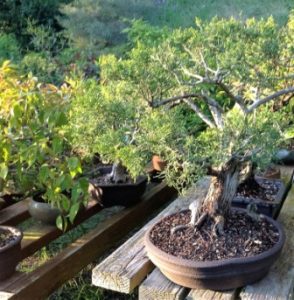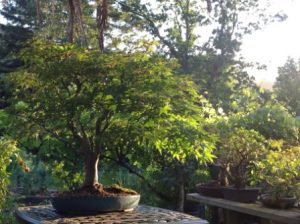The Taskmaster (aka Chris Ross) explains what to do, how to do it and why for bonsaists in the San Francisco Bay Area.
JanFebMarAprMayJunJulAugSepOctNovDec
May
May in the Bonsai world is a busy time. And it has such a positive feel just to say it, doesn’t it? As in things May be better this year; or, this little beauty May make it to the show this year; or, May is the ideal time to…
 It’s the ideal time to finish repotting the evergreens that didn’t get done yet. First the broadleaf evergreens, then the junipers and conifers. Put them in bright shade only, constantly damp but never soaking and no food for three weeks or so.
It’s the ideal time to finish repotting the evergreens that didn’t get done yet. First the broadleaf evergreens, then the junipers and conifers. Put them in bright shade only, constantly damp but never soaking and no food for three weeks or so.
It’s the ideal time late in the month to feed 70/30% cottonseed/bone meal, a tablespoon or two sprinkled around the outside one third edge of the pot and scratched in with a chopstick on all pots. That’s the traditional and original organics approach. There are other organic mixes that yield nitrogen faster, water soluble pellets and granulars with varied NPK numbers to suit your preference. Some growers put it in tea bags, available at most Asian markets in two or three sizes and in packs of ten to fifty, because they don’t want anything in the pot that might possibly clog the drainage capability of the soil. Then they are careful to water through the tea bags every time so the contents of the tea bags is certain to be carried into the soil. At a guess, the tea bags must be replaced every four to six weeks.
This is the ideal time to pinch back everything to create branch ramification and budding back. On deciduous trees, find where you want the side branching to occur and cut off everything beyond that point, leaving a stem for dieback, to be removed later (unless you want the branch to be thicker-just let it grow long for now). On evergreens pinch off just the bright green tips, to remove a hormone that they produce which prevents backbudding. Junipers are currently thought to grow better if left alone to grow strongly until cutting back becomes possible.
This is the ideal time to deal with various pests that are in their prime and proliferating right now. Paint Neem oil or Volck oil onto scale bugs with a large watercolor brush like the ones you get with a paint-by-numbers kit or a fat soft Q-tip. Picking them off may damage the bark that the tree must repair and leave eggs and larvae behind for another damaging round. Horticultural oils smother all. Spray Malathion or Sevin or Ortho Max in the evening or very early morning every two or three weeks on non-flowering plants for aphids, ants, inchworms, stickworms and leafrollers. Try to use non-chemical solutions on all your trees before resorting to the hard stuff, and especially on the flowering and fruiting trees where pollinating insects tend to hang out.
 It’s the ideal time at month’s middle or end to defoliate healthy, vigorous deciduous trees partially or fully to create smaller leaves and more intense Fall color. But not beech trees, they won’t push out any new growth. This defoliation is usually only done on trees that are far enough along in the shaping and styling of bonsai cultivation to be trees that can be shown. If they need to grow some more or be styled, this can only weaken the tree a bit and slow it down temporarily.
It’s the ideal time at month’s middle or end to defoliate healthy, vigorous deciduous trees partially or fully to create smaller leaves and more intense Fall color. But not beech trees, they won’t push out any new growth. This defoliation is usually only done on trees that are far enough along in the shaping and styling of bonsai cultivation to be trees that can be shown. If they need to grow some more or be styled, this can only weaken the tree a bit and slow it down temporarily.
The ideal time to lightly prune back flowering trees that have finished blooming. Next year’s blooms will be on this Spring’s new growth, so prune to preserve and protect only the new growth that is in the right places. The old blooming sections can be removed or shortened, and the upgrowing suckers can be removed (or pruned back hard; but leave a bit and don’t cut back quite so far if a spot of green or some growth is needed in that location, for now, to balance the look of the tree).
– The Taskmaster

